Silkworm farmers embrace harvest season of 'golden cocoons' in Tongxiang, E China
People's Daily Online
1622546912000
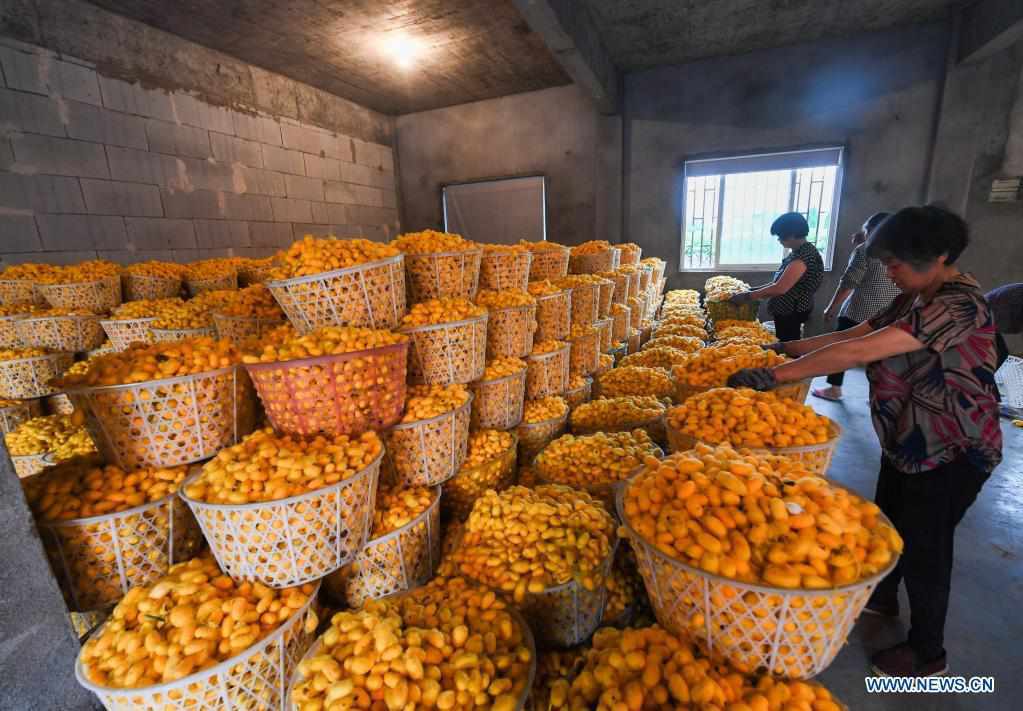
Staff arrange purchased "golden cocoons" at a sericulture cooperative in Jiansheng Village of Tongxiang City, east China's Zhejiang Province, May 26, 2021. Tongxiang, east China's Zhejiang Province, is famous for its over 4,000 years' history of sericulture. Its silkworm breeding and mulberry planting tradition has been listed by the State Council as the national intangible cultural heritage. A new variety of silkworm called "golden cocoon" is pale gold in color. The processed silk of "golden cocoon" has higher lutein content and better antibacterial effect than the ordinary ones. Products made of the cocoons are favored by domestic and overseas markets. The "golden cocoon" has made a great contribution to upgrading local traditional agriculture and increasing farmers' income. In these days, local silkworm farmers embrace the harvest season of the "golden cocoons". (Xinhua/Xu Yu)
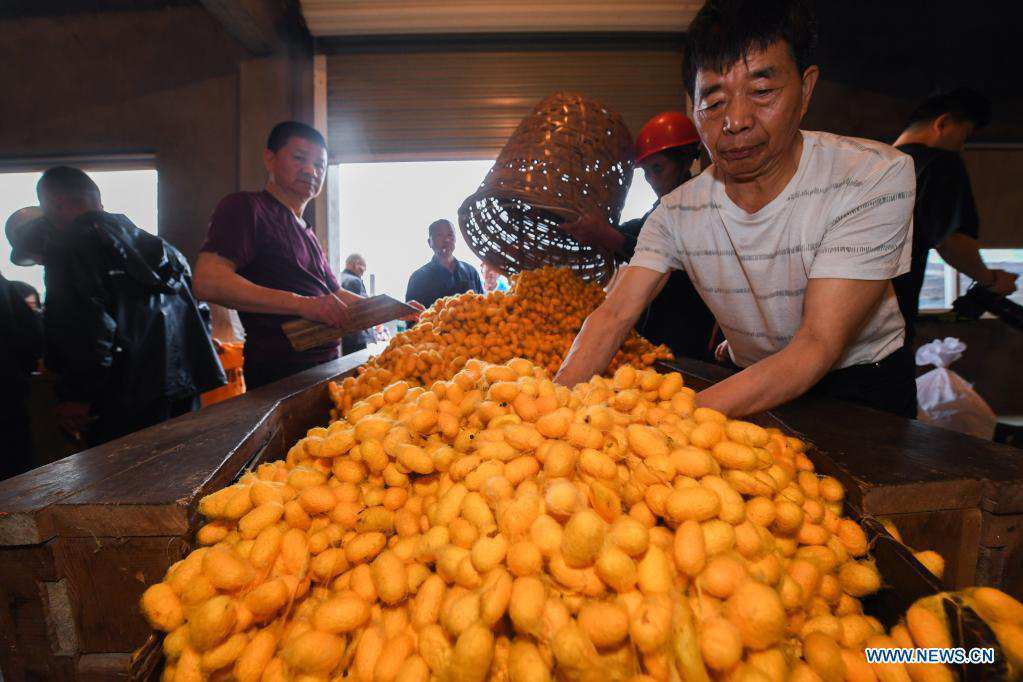
Staff arrange purchased "golden cocoons" at a sericulture cooperative in Jiansheng Village of Tongxiang City, east China's Zhejiang Province, May 26, 2021. Tongxiang, east China's Zhejiang Province, is famous for its over 4,000 years' history of sericulture. Its silkworm breeding and mulberry planting tradition has been listed by the State Council as the national intangible cultural heritage. A new variety of silkworm called "golden cocoon" is pale gold in color. The processed silk of "golden cocoon" has higher lutein content and better antibacterial effect than the ordinary ones. Products made of the cocoons are favored by domestic and overseas markets. The "golden cocoon" has made a great contribution to upgrading local traditional agriculture and increasing farmers' income. In these days, local silkworm farmers embrace the harvest season of the "golden cocoons". (Xinhua/Xu Yu)
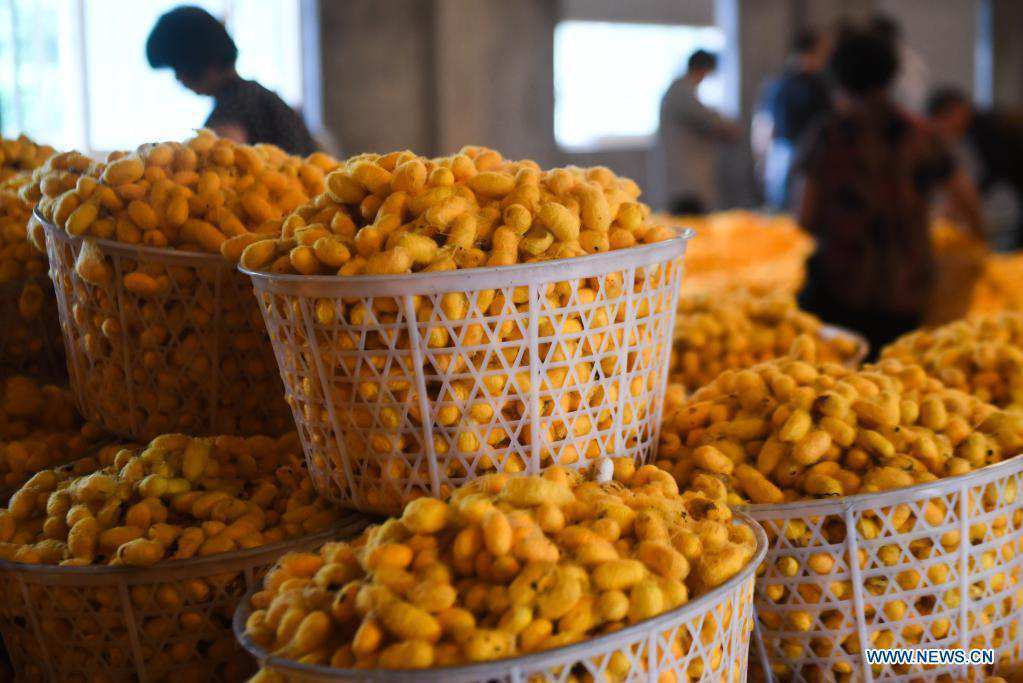
Photo taken on May 26, 2021 shows purchased "golden cocoons" at a sericulture cooperative in Jiansheng Village of Tongxiang City, east China's Zhejiang Province. Tongxiang, east China's Zhejiang Province, is famous for its over 4,000 years' history of sericulture. Its silkworm breeding and mulberry planting tradition has been listed by the State Council as the national intangible cultural heritage. A new variety of silkworm called "golden cocoon" is pale gold in color. The processed silk of "golden cocoon" has higher lutein content and better antibacterial effect than the ordinary ones. Products made of the cocoons are favored by domestic and overseas markets. The "golden cocoon" has made a great contribution to upgrading local traditional agriculture and increasing farmers' income. In these days, local silkworm farmers embrace the harvest season of the "golden cocoons". (Xinhua/Xu Yu)
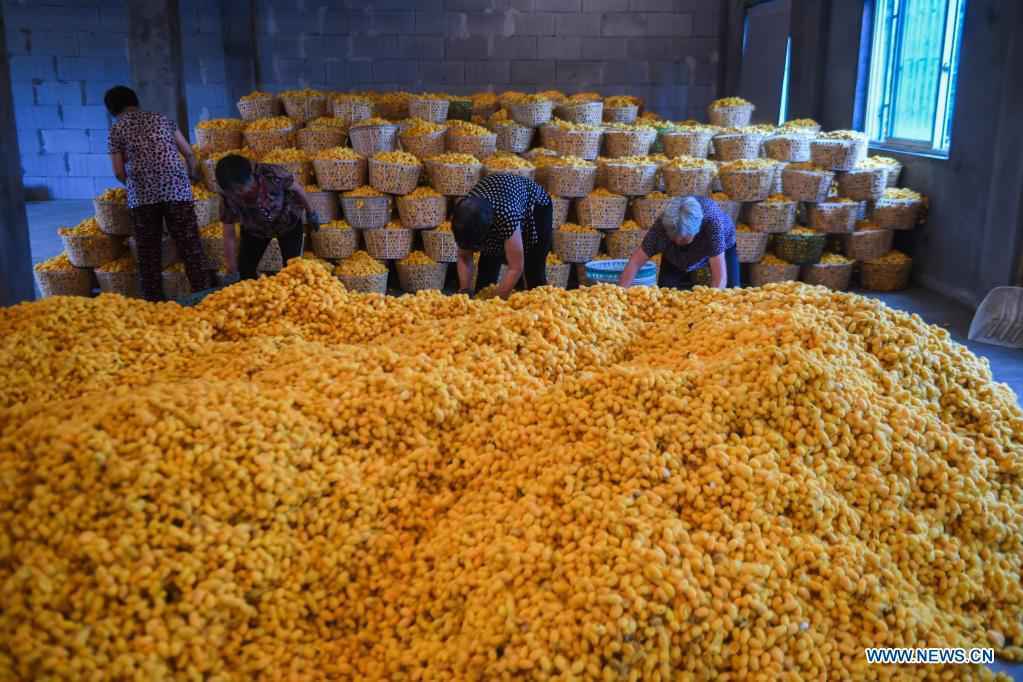
Staff arrange purchased "golden cocoons" at a sericulture cooperative in Jiansheng Village of Tongxiang City, east China's Zhejiang Province, May 26, 2021. Tongxiang, east China's Zhejiang Province, is famous for its over 4,000 years' history of sericulture. Its silkworm breeding and mulberry planting tradition has been listed by the State Council as the national intangible cultural heritage. A new variety of silkworm called "golden cocoon" is pale gold in color. The processed silk of "golden cocoon" has higher lutein content and better antibacterial effect than the ordinary ones. Products made of the cocoons are favored by domestic and overseas markets. The "golden cocoon" has made a great contribution to upgrading local traditional agriculture and increasing farmers' income. In these days, local silkworm farmers embrace the harvest season of the "golden cocoons". (Xinhua/Xu Yu)

Silkworm farmers process "golden cocoons" in Qujiabang Village of Zhouquan Town in Tongxiang City, east China's Zhejiang Province, May 25, 2021. Tongxiang, east China's Zhejiang Province, is famous for its over 4,000 years' history of sericulture. Its silkworm breeding and mulberry planting tradition has been listed by the State Council as the national intangible cultural heritage. A new variety of silkworm called "golden cocoon" is pale gold in color. The processed silk of "golden cocoon" has higher lutein content and better antibacterial effect than the ordinary ones. Products made of the cocoons are favored by domestic and overseas markets. The "golden cocoon" has made a great contribution to upgrading local traditional agriculture and increasing farmers' income. In these days, local silkworm farmers embrace the harvest season of the "golden cocoons". (Xinhua/Xu Yu)
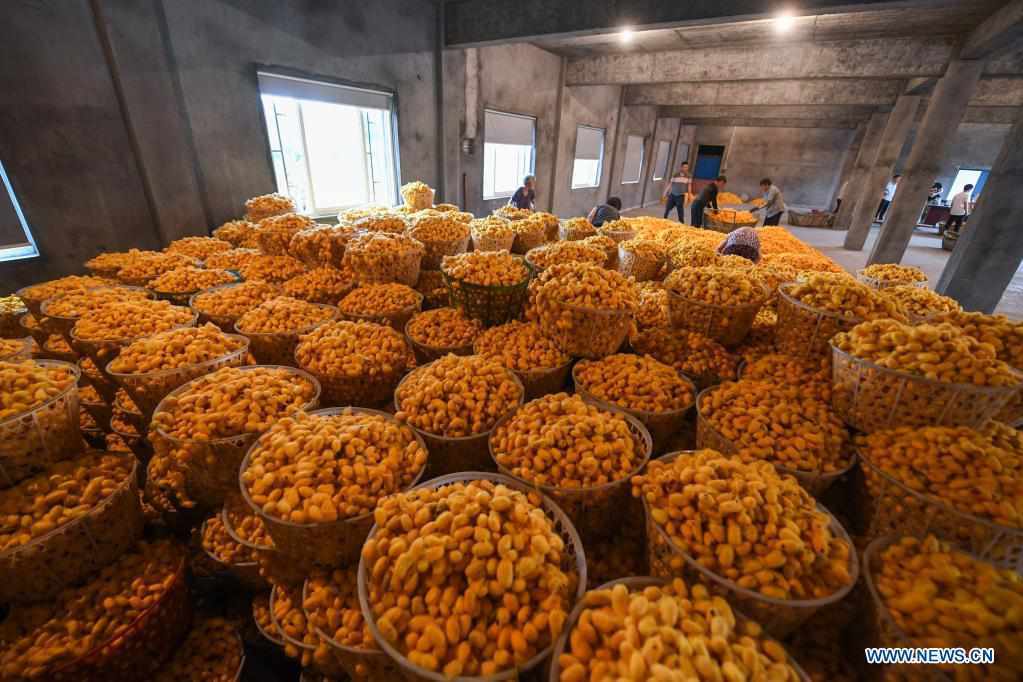
Staff arrange purchased "golden cocoons" at a sericulture cooperative in Jiansheng Village of Tongxiang City, east China's Zhejiang Province, May 26, 2021. Tongxiang, east China's Zhejiang Province, is famous for its over 4,000 years' history of sericulture. Its silkworm breeding and mulberry planting tradition has been listed by the State Council as the national intangible cultural heritage. A new variety of silkworm called "golden cocoon" is pale gold in color. The processed silk of "golden cocoon" has higher lutein content and better antibacterial effect than the ordinary ones. Products made of the cocoons are favored by domestic and overseas markets. The "golden cocoon" has made a great contribution to upgrading local traditional agriculture and increasing farmers' income. In these days, local silkworm farmers embrace the harvest season of the "golden cocoons". (Xinhua/Xu Yu)

Silkworm farmers sell "golden cocoons" to a sericulture cooperative in Jiansheng Village of Tongxiang City, east China's Zhejiang Province, May 26, 2021. Tongxiang, east China's Zhejiang Province, is famous for its over 4,000 years' history of sericulture. Its silkworm breeding and mulberry planting tradition has been listed by the State Council as the national intangible cultural heritage. A new variety of silkworm called "golden cocoon" is pale gold in color. The processed silk of "golden cocoon" has higher lutein content and better antibacterial effect than the ordinary ones. Products made of the cocoons are favored by domestic and overseas markets. The "golden cocoon" has made a great contribution to upgrading local traditional agriculture and increasing farmers' income. In these days, local silkworm farmers embrace the harvest season of the "golden cocoons". (Xinhua/Xu Yu)
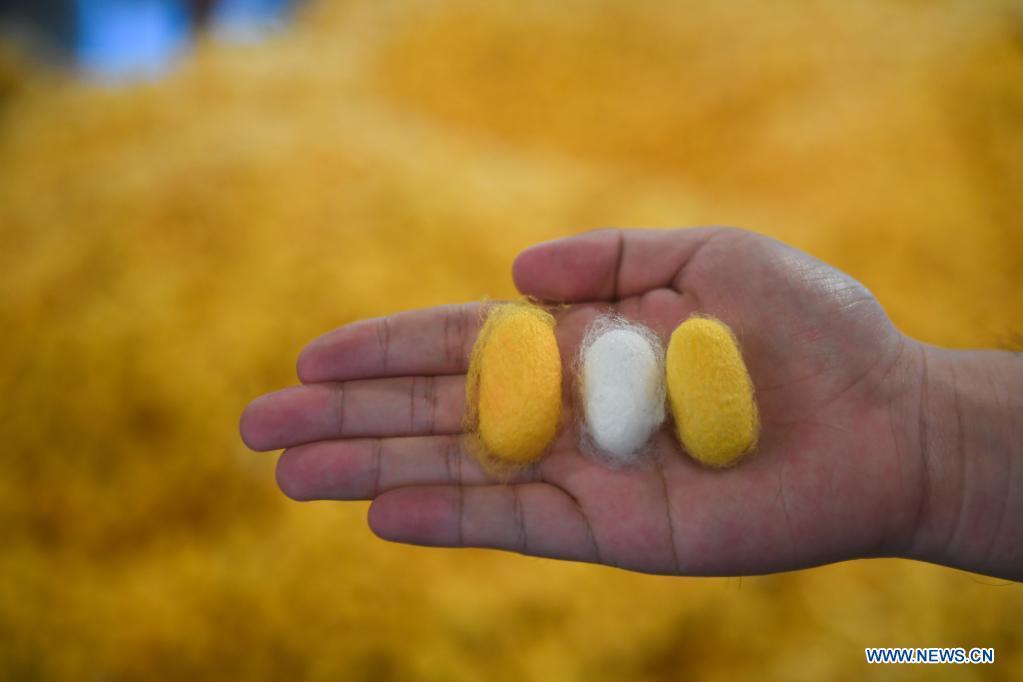
A staff member shows "golden cocoons" and an ordinary silkworm cocoon at a sericulture cooperative in Jiansheng Village of Tongxiang City, east China's Zhejiang Province, May 26, 2021. Tongxiang, east China's Zhejiang Province, is famous for its over 4,000 years' history of sericulture. Its silkworm breeding and mulberry planting tradition has been listed by the State Council as the national intangible cultural heritage. A new variety of silkworm called "golden cocoon" is pale gold in color. The processed silk of "golden cocoon" has higher lutein content and better antibacterial effect than the ordinary ones. Products made of the cocoons are favored by domestic and overseas markets. The "golden cocoon" has made a great contribution to upgrading local traditional agriculture and increasing farmers' income. In these days, local silkworm farmers embrace the harvest season of the "golden cocoons". (Xinhua/Xu Yu)

Photo taken on May 19, 2021 shows a "golden cocoon" and silkworms at a villager's silkworm breeding farm in Jiansheng Village of Tongxiang City, east China's Zhejiang Province. Tongxiang, east China's Zhejiang Province, is famous for its over 4,000 years' history of sericulture. Its silkworm breeding and mulberry planting tradition has been listed by the State Council as the national intangible cultural heritage. A new variety of silkworm called "golden cocoon" is pale gold in color. The processed silk of "golden cocoon" has higher lutein content and better antibacterial effect than the ordinary ones. Products made of the cocoons are favored by domestic and overseas markets. The "golden cocoon" has made a great contribution to upgrading local traditional agriculture and increasing farmers' income. In these days, local silkworm farmers embrace the harvest season of the "golden cocoons". (Xinhua/Xu Yu)

Photo taken on May 25, 2021 shows silk processed from "golden cocoons" at a textile enterprise in Qujiabang Village of Zhouquan Town in Tongxiang City, east China's Zhejiang Province. Tongxiang, east China's Zhejiang Province, is famous for its over 4,000 years' history of sericulture. Its silkworm breeding and mulberry planting tradition has been listed by the State Council as the national intangible cultural heritage. A new variety of silkworm called "golden cocoon" is pale gold in color. The processed silk of "golden cocoon" has higher lutein content and better antibacterial effect than the ordinary ones. Products made of the cocoons are favored by domestic and overseas markets. The "golden cocoon" has made a great contribution to upgrading local traditional agriculture and increasing farmers' income. In these days, local silkworm farmers embrace the harvest season of the "golden cocoons". (Xinhua/Xu Yu)

A villager harvests "gloden cocoons" at his silkworm breeding farm in Jiansheng Village of Tongxiang City, east China's Zhejiang Province on May 25, 2021. Tongxiang, east China's Zhejiang Province, is famous for its over 4,000 years' history of sericulture. Its silkworm breeding and mulberry planting tradition has been listed by the State Council as the national intangible cultural heritage. A new variety of silkworm called "golden cocoon" is pale gold in color. The processed silk of "golden cocoon" has higher lutein content and better antibacterial effect than the ordinary ones. Products made of the cocoons are favored by domestic and overseas markets. The "golden cocoon" has made a great contribution to upgrading local traditional agriculture and increasing farmers' income. In these days, local silkworm farmers embrace the harvest season of the "golden cocoons". (Xinhua/Xu Yu)
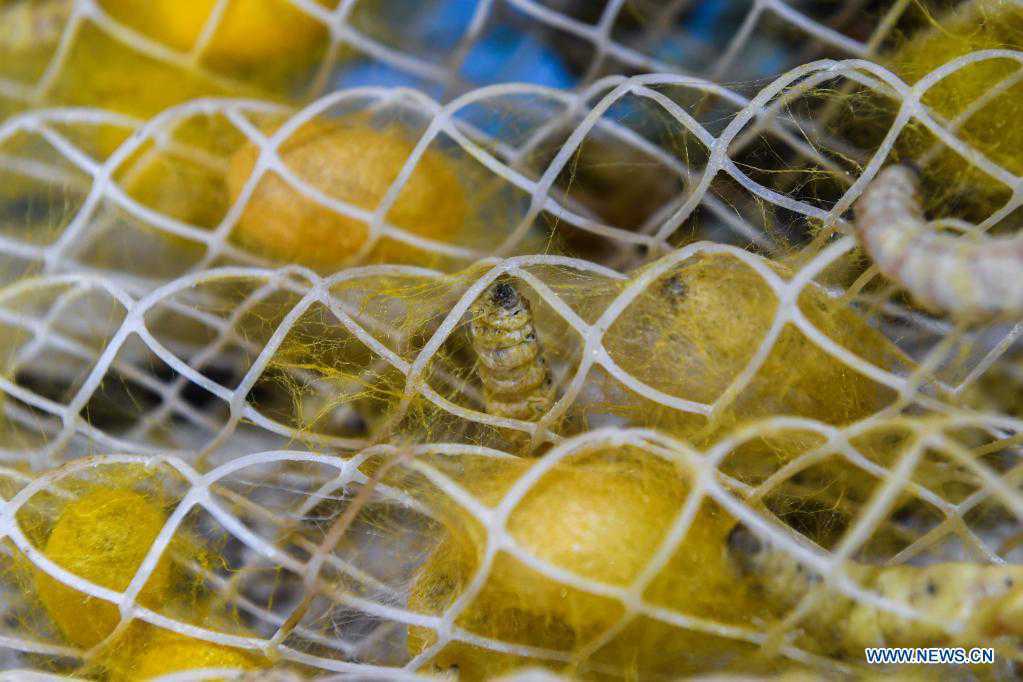
Photo taken on May 25, 2021 shows silkworms spinning cocoons at a villager's silkworm breeding farm in Jiansheng Village of Tongxiang City, east China's Zhejiang Province. Tongxiang, east China's Zhejiang Province, is famous for its over 4,000 years' history of sericulture. Its silkworm breeding and mulberry planting tradition has been listed by the State Council as the national intangible cultural heritage. A new variety of silkworm called "golden cocoon" is pale gold in color. The processed silk of "golden cocoon" has higher lutein content and better antibacterial effect than the ordinary ones. Products made of the cocoons are favored by domestic and overseas markets. The "golden cocoon" has made a great contribution to upgrading local traditional agriculture and increasing farmers' income. In these days, local silkworm farmers embrace the harvest season of the "golden cocoons". (Xinhua/Xu Yu)
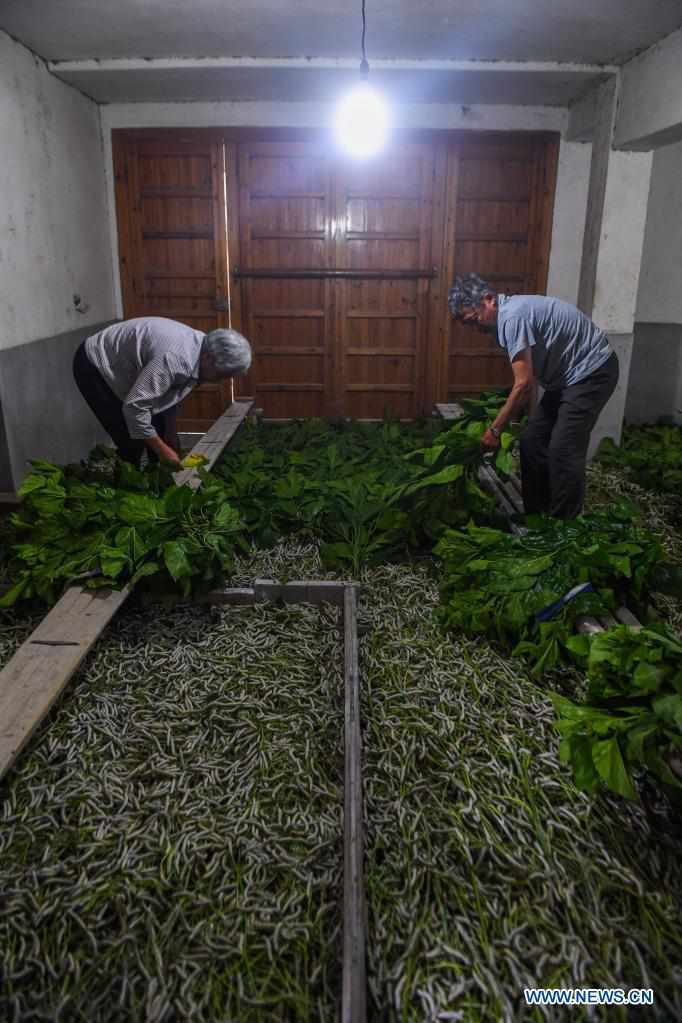
A villager and his wife feed silkworms at their silkworm breeding farm in Jiansheng Village of Tongxiang City, east China's Zhejiang Province on May 19, 2021. Tongxiang, east China's Zhejiang Province, is famous for its over 4,000 years' history of sericulture. Its silkworm breeding and mulberry planting tradition has been listed by the State Council as the national intangible cultural heritage. A new variety of silkworm called "golden cocoon" is pale gold in color. The processed silk of "golden cocoon" has higher lutein content and better antibacterial effect than the ordinary ones. Products made of the cocoons are favored by domestic and overseas markets. The "golden cocoon" has made a great contribution to upgrading local traditional agriculture and increasing farmers' income. In these days, local silkworm farmers embrace the harvest season of the "golden cocoons". (Xinhua/Xu Yu)


